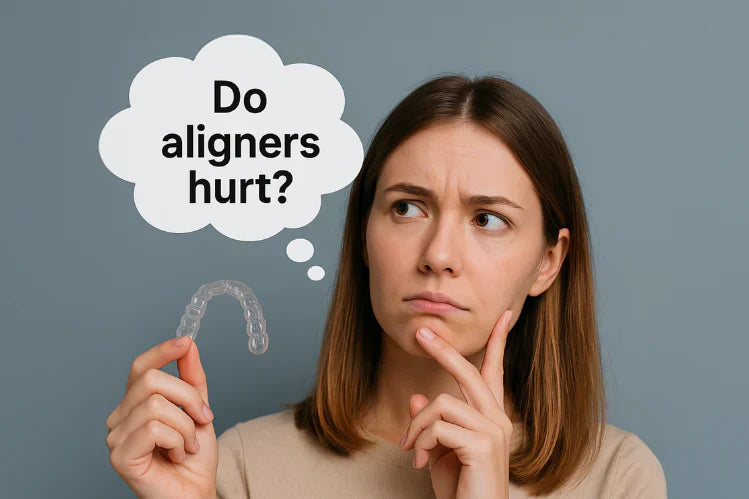
Table of Contents
- What Are Clear Aligners?
- Do Aligners Hurt?
- Causes of Clear Aligner Discomfort and Pain
- How Long Do Aligners Hurt?
- Clear Aligner Pain Management
- Do Invisible Braces Hurt More Than Traditional Braces?
- Potential Clear Aligner Side Effects
- When Aligner Discomfort Isn’t Normal
- Do Clear Aligners Hurt? The Answer Lies Here
- FAQs
Clear aligners have literally taken orthodontics by storm. Modern and lifestyle-friendly, these clear, nearly invisible, and removable trays serve as a major alternative to the age-old metal braces. Whether you are presenting at a big event, going clubbing, or just want to drink coffee without wires getting in the way, aligners can always make the journey toward attaining straighter teeth much more enjoyable.
But let's be real: no orthodontic treatment is completely pain-free. Among the prominent questions people ask about clear aligners, “Do aligners hurt?” tops the list and for good reason. After all, they are moving your teeth into different positions, and that really cannot be done without some discomfort.
So what does that discomfort actually feel like? In this blog, we’ll walk you through everything you need to know about aligner discomfort, what causes it, how intense it might be, and most importantly, how to manage and minimize it so it doesn’t get in the way of your daily life.
What Are Clear Aligners?
Clear aligners are personalized, removable trays that gently move your teeth into their ideal alignment over time. Made from BPA-free plastic, these trays are virtually invisible and are changed every 1–2 weeks to continue the progression of your treatment.
Aligners are favored for their aesthetic appeal, comfort, and the freedom they offer, that is, you can remove them while eating or brushing. However, while they are far more comfortable than metal braces, they’re not completely pain-free. Popular brands, including Smilepath , even offer at-home treatment to let you enjoy a more convenient and comforting experience.
Do Aligners Hurt?
The short answer is: yes, aligners can cause some discomfort, especially in the beginning. But it’s typically mild and temporary. Most users describe the sensation as pressure rather than sharp pain. This sensation indicates that your aligners are working as intended, gradually and effectively shifting your teeth into place.
This discomfort typically arises at the beginning of your aligner treatment or when transitioning to a new set of trays. Each new tray is slightly tighter to shift your teeth further, which can cause minor aches or soreness.
Causes of Clear Aligner Discomfort and Pain
Tooth Movement
Clear aligners gradually move your teeth by exerting steady, gentle pressure. This pressure can make your teeth feel sensitive or sore, particularly in the first few days of wearing a new aligner set.
Tray Tightness
Every time you switch to a new aligner tray, usually every one to two weeks, it might feel tight. That snug fit means the tray is doing its job, guiding your teeth to their next position. While the tightness may be uncomfortable at first, it usually eases up within a few days as your teeth adjust to the new aligner.
Wearing Inconsistently
It might be tempting to take your aligners out more often than recommended, especially when you’re eating or during social events. But inconsistent wear can backfire. If you don’t wear your aligners for the recommended 20–22 hours a day, your teeth can shift slightly out of place, making it painful when you put the trays back in.
Underlying Sensitivity
If you already have sensitive teeth, gum issues, or other underlying dental problems, you might experience more discomfort than usual during treatment. Pre-existing sensitivity can amplify the pressure you feel from the aligners or even cause tenderness in your gums. If this applies to you, it's a good idea to discuss your concerns with your dentist before starting treatment, so they can offer guidance or recommend solutions to ease the sensitivity.
How Long Do Aligners Hurt?
How long do aligners hurt? It varies from person to person. Generally, discomfort is most noticeable:
- In the initial days after beginning your aligner treatment.
- Right after switching to a new tray in your treatment sequence.
In most cases, the discomfort lasts between 1 to 3 days, with the first 24 hours being the most intense. After that, the pressure eases as your teeth adjust to their new position.
If the pain persists beyond a few days or becomes sharp or unbearable, it may be time to consult your dentist or aligner provider.
Clear Aligner Pain Management
Switch Aligners at Night
Switch to a new tray at night so you can sleep through the initial period of discomfort.
Use Cold Compresses
Place a cold pack on your cheeks to help ease the soreness.
Take Over-the-Counter Pain Relievers
Pain killers like Ibuprofen or acetaminophen can help ease the pain.
Apply Orthodontic Wax
Use orthodontic wax to cover any sharp edges causing irritation.
Drink Cold Water
Sipping on cold water can numb mild discomfort.
Wear Aligners Consistently
The more consistently you wear your aligners, the quicker your mouth gets used to them.
Use a Chewie
Chewies are the soft, rubbery cylinders that help your aligners fit better and reduce pressure.
Do Invisible Braces Hurt More than Traditional Braces?

One of the most common comparisons made is between invisible braces and traditional braces. In most cases, clear aligners are more comfortable compared to traditional braces.
Traditional braces involve brackets, wires, and often rubber bands, which can cause sores and cuts inside of your cheeks and lips, and significant pressure on your teeth. Clear aligners, on the other hand, are made from sleek and smooth plastic material. While both methods cause some discomfort due to tooth movement, aligners are generally less painful and more manageable in daily life.
Potential Clear Aligner Side Effects
Although aligners are considered safe and effective, there are a few potential clear aligner side effects to be aware of. These side effects include:
- Gum Irritation: Some users may experience mild inflammation or sensitivity.
- Dry Mouth: Keeping the trays in all day can lead to decreased saliva flow.
- Slight Lisp: A temporary lisp may occur, especially when you first start wearing aligners.
These side effects are usually minor and fade as your mouth adjusts to the aligners.
When Aligner Discomfort Isn’t Normal
While mild aligner discomfort is normal, there are times when it may signal a problem. In these cases, it is best to consult your dentist or customer support team for guidance. These cases include:
- Persistent Sharp Pain that lasts beyond a few days.
- Bleeding Gums or Sores, especially if the trays are ill-fitting.
- Broken Aligners can cause cuts or further misalignment.
- Unusual Swelling or Numbness could indicate an allergic reaction or infection.
Do Clear Aligners Hurt? The Answer Lies Here
So, do aligners hurt? Yes, but only a little, and only for a short time. Most of the discomfort comes from the aligners doing exactly what they’re supposed to do: gradually shifting your teeth for a straighter smile. The good news is that the pain is manageable, and there are plenty of ways to reduce it, like over-the-counter pain relievers or drinking cold water.
If you are prepared for a short adjustment period and use the proper clear aligner pain management tips, you'll likely find the experience smooth and rewarding. Always follow your provider’s instructions and don’t hesitate to ask for help if something doesn’t feel right. With patience and consistency, you'll soon be smiling with confidence, pain-free and beautifully aligned!
FAQs
While it is perfectly normal to experience some soreness or discomfort with any orthodontic treatment, including clear aligners, severe pain or discomfort is not typical. With clear aligners, you will only experience minor discomfort due to the tooth movement.
You will experience minor discomfort with clear aligners only for the first few days due to the pressure they exert on teeth to move them.
Experiencing discomfort and feeling pressure on teeth with clear aligners is actually a sign that your clear aligners are working.
Citations:
Clear Aligners 101: Aligner Attachments. (n.d.). Colgate. https://www.colgate.com/en-us/oral-health/adult-orthodontics/clear-aligners-101-aligner-attachments
Fletcher, J. (2019e, December 4). Do braces hurt? What to expect. https://www.medicalnewstoday.com/articles/327201
Cherney, K. (2021, February 17). Does invisalign hurt? Healthline. https://www.healthline.com/health/dental-and-oral-health/does-invisalign-hurt








 Australia
Australia New Zealand
New Zealand Malaysia
Malaysia English
English Portuguese
Portuguese English
English English
English English
English English
English English
English Canada
Canada